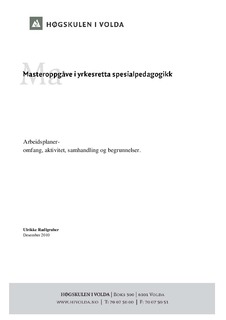| dc.description.abstract | Summary
The subject of this study is the use of work plans (schemes of work) in school. A work plan is a document that describes assignment the students are expected to do during a particular period of time. It can be used to solve didactical challenges connected to pedagogic differentiation and self- regulated learning. The use of work plans is not developed as a consequence of departmental directives, but a tool made on a local level. Recent classroom research (Klette et al 2008, Haug 2009) shows that one of the most visible trends is that the amount of individual work is increasing at the expense of the collective teaching, and the use of work plans is a part of this picture. The use of work plans has been criticized because it leads to the ‘classroom’ as a learning arena becoming less important and the teacher adopting a background role. As a result, the student must take more responsibility for their own learning, and this leads to different outcomes for the students (Klette 2007). This study has three main areas of discussion: How widespread is the use work plans in school? Which activities and types of interaction have teacher and student when the work plans are used as a learning tool? What are the teacher’s intentions in their use of work plans? Data in this study are collected from a survey to teachers and quantitative classroom observations at levels 3, 6, and 9, which are based upon the research project, Quality in Education (KIO) at Volda University Collage. Collection of data took place in 2007-2008. The main findings in this present research are that work plans are used at all levels at Primary School level, but the KIO data identifies variations with regards to the design and application of these planning documents. Most work plans in use are common work plans for several subjects. These plans are used to a limited extent in schools at levels 3 through to 6, but increasing by year 9. By year 9 the students follow the work plan for a third of the time of their individual work. Teachers both justify and define the schemes of work principally as a means of informing students and parents about school work and homework in an agreed period of time. It may appear that the teachers have no holistic teaching methodology behind the use of work plans. The teacher’s main educational reasons for using work plans are pedagogic differentiation. At level 9 work plans are used as the main tool when the student is working with differential tasks, whilst year 6 students rarely work with differential tasks when they are using a work plan. | no_NO |
